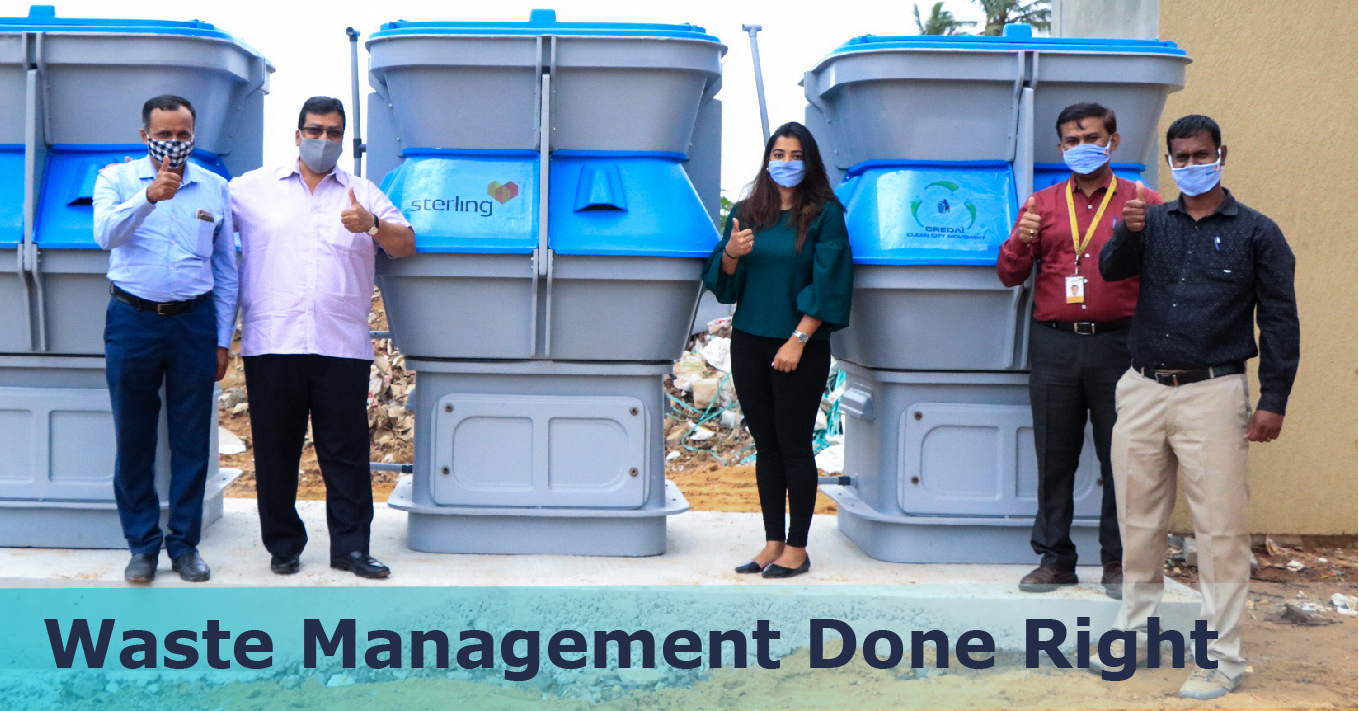Waste Management Done Right
How is Sterling making sure that waste management is done right?
We have installed Composting units at Sterling Ascentia which will take care of all the wet waste generated in the community in an eco friendly manner. These units do not use electricity but instead use enzymes to break down waste and generate manure which will be used for the landscaping in the project. This is the first pilot project in Bangalore and Karnataka under the Credai Clean City Movement Initiative.
We come across plastic waste almost every day of our lives. We know that it is non-biodegradable and unhealthy for nature, yet we throw out the same without caution. Today, we want to address this serious issue that is suffocating our earth and highlight how we can save this planet for the future generations.
What is waste management?
It involves all the activities required to manage waste from its creation to its final disposal. This includes, amongst other things, collection, transport, treatment and disposal of garbage, sewage, and other waste products together with monitoring and regulation. It also comprises the legal and regulatory framework that relates to waste management.
How does waste disposal affect nature?
Chemicals contaminating the soil: When waste ends up in landfills, harmful chemicals seep out into the soil and contaminate it. This hurts plants, along with animals and even humans who come into contact with the soil. Once polluted, contaminated soil is very difficult to clean, and will likely have to be dug up to clear the area.
Surface water and groundwater contamination:Chemicals don’t just run from garbage into the soil. They can also reach nearby potable water sources, such as rivers and lakes and also seep into groundwater. This changes the levels of chemicals in the water for the worse. The result? The ecosystems such as fish habitats in the water get hurt, as do any creatures that drink from the water source including humans.
Air pollution:Garbage creates air pollution due to gasses and chemicals emanating from it. This air pollution usually occurs in open-air dumps, where a lot of our waste and electronic trash goes, and through incinerators used at garbage disposal sites. The air pollution from incineration is very toxic, that it can even release harmful substances that contribute to acid rain.
Increase in methane levels:Garbage landfills release methane gas as it rots, and methane is one of the greenhouse gases that contributes to global warming – and can also be ignited to cause an explosion.
What are the means of waste disposal in the current scenario?
Composting and Vermicomposting: This method is useful for biodegradable waste disposal. The part of the garbage which decomposes in nature to form harmless substances is called biodegradable (plants and animal waste). Different biodegradable waste can be dumped in a pit. Here, it is allowed to decompose and it gets converted to useful manure. This process is known as composting. The process can take upto 2 to 3 months. To make the process fast, worms may be used for composting. This method is called vermicomposting. Vermicompost is a very high-quality manure.
Landfilling:A low-lying designated area of the city where garbage is collected and dumped is known as a landfill. The garbage is loaded into the truck and dumped in the landfill. When that area is fully covered with garbage, it is covered with layers of soil. This place can be converted into a park or a playground.
Incineration:This method is mainly used to dispose off medical and other solid waste. In this method, garbage is burnt at a high temperature in a special furnace called an incinerator. This converts large amounts of garbage into a small amount of ash which can be disposed of in the landfill site or used in construction work.
What is the future of waste management?
Circular rethinking:We must agree on a linear make-use-dispose model on which we have built our society. It needs to be ditched for good. It’s all about going “circular” these days. To start off, it means a massive overhaul on how waste is conceived. Even the word is loaded: “waste” which isn’t actually wasted material, it’s a valuable commodity. And the first companies that need to recognize this are the waste management companies.
Turning waste into energy:Even if the companies do go through the previous method, they will still need business models that can turn a profit. One of the solutions is turning waste into energy. According to latest Grand View Research, the global market for turning rubbish into power is expected to reach $37.64bn by 2020. The new generation of firms should start using 100% biodegradable feedstock and advanced biotechnologies.
Recyclability:The next hurdle for manufacturers is recycling materials. Reusing a metal like copper is easy enough (its dexterity is behind the spike in metal thefts). Recycling plastics or other complex materials is a completely different ball game altogether.
Convincing consumers:It’s not just business that needs to change, as end consumers our habits need a radical shift too. We need to spend time thinking about the waste we generate as individuals. Half of the food produced around the world ends up in the bin, according to the Institution of Mechanical Engineers.
- October 31, 2020
- No Comments

